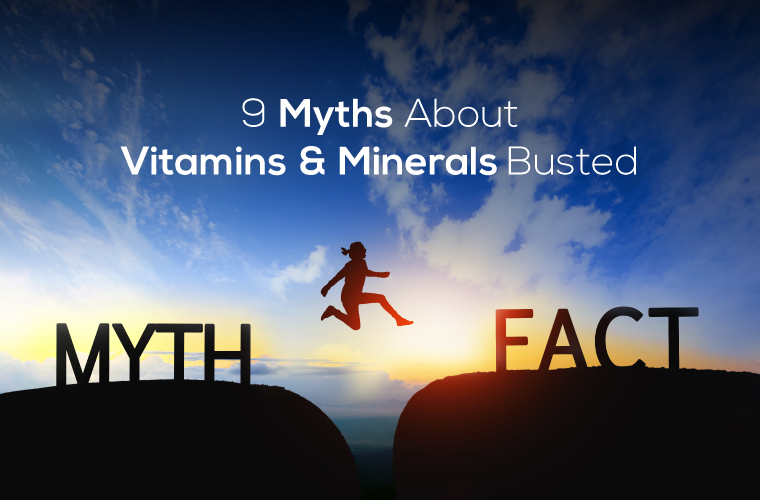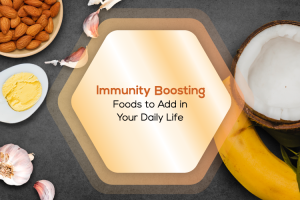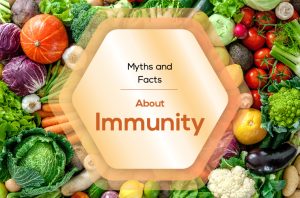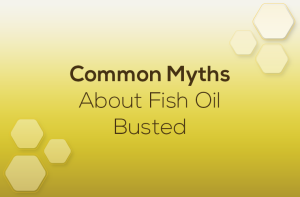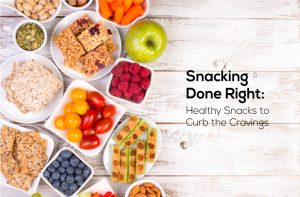Vitamins and minerals are essential nutrients for our body. They play hundreds of functions in our body like converting food to energy, providing bone strength, repairing cellular damage, boosting immunity, fighting free radicals and so on. Such extensive roles of Vitamins & minerals in our body are primarily the reason we hear a lot about them wherever we go including the internet. With such a large pool of information available at our fingertips, it becomes difficult to weigh the merit of the information and check for its validity. We take information at its face value, giving rise to several misconceptions about the roles, functions and food sources of Vitamin & minerals.
Wondering if there is something about Vitamin and minerals that you’ve heard to be true but might be a myth instead? Read along to find out if you’ve had any of them.
Myth #1: Vitamin C is a remedy for the cold
Reality: We often think that increasing our citrus intake during a cold is a guaranteed way of managing the symptoms and recovering fast. But it’s only a half truth. It is true that a steady supply of Vitamin C boosts immunity, reduces the chances of infection and cuts the recovery time by hours. However, Vitamin C is useful before you’ve caught an infection. Stocking up on Vitamin C when you’ve already caught a cold doesn’t help in reducing the infection, fight the infection or condense the recuperation time. Eat those oranges while they’re in season, but do not expect them to treat your sniffles.
Myth #2: Citrus fruits are the only sources of Vitamin C
Reality: This is another notion on similar lines – the ‘C’ in Vitamin C is synonymous with citrus and that only citrus fruits contain Vitamin C. Generally, the food items that come to mind when considering this vitamin are oranges, lemon, lime, etc. A 100 g portion of oranges contains about 60 mg of Vitamin C. While these are excellent sources of Vitamin C, they’re not the only ones. Some lesser known food items that hold reservoirs of Vitamin C include guavas (228 mg), chili peppers (144 mg), bell peppers (242.5 mg), thyme (160 mg) and papayas (60 mg).
Myth #3: Spinach is the best source of iron
Reality: Popeye helped us internalize that spinach is a superfood, the go-to source for Iron and the secret behind his superhuman strength. But a closer look reveals a different story: 100 g of spinach contains about 3.6 mg of Iron, which is around 17% of recommended dietary allowance of adult women and 21% of adult men. That is a small amount when compared to other plant sources. The iron content in animal-derived foods, such as organ meat and seafood, far outweigh that in spinach. Chicken liver contains 12.9 mg Iron, cooked clam contains up to 28 mg Iron per 100 g portion size. Even in the plant-based foods, spirulina (28.5 mg), thyme (124 mg), parsley (97.8 mg), chickpeas (6.2 mg) and soybeans (15.7 mg) leave spinach behind in the iron content. So, the next time spinach takes the center stage in talks about iron, remember that there are better ways of obtaining this nutrient.
Myth #4: Vegetarians don’t get adequate Iron and Vitamin B12
Reality: This myth does carry some merit to it but is the classic example of a half-truth. It’s true that bioavailable forms of Iron (heme iron) and Vitamin B12, those that are readily absorbed by the body, are found in animal sources only. Therefore, Iron’s RDA for vegetarians is generally 1.8 times that of non-vegetarians [1]. However, vegetarians can get their daily requirement of Iron from the plant sources (non-heme iron) as well. Our body metabolizes non-heme iron and converts it to heme iron which then utilized by the body. Spices (thyme, parsley), chickpeas, soybeans, red kidney beans, sesame seeds, spirulina are some of the excellent sources of plant based iron
Likewise, it is widely believed that Vegans do not get their Vitamin B12. However, many cereals and fortified foods, like nutritional yeast and non-dairy milk alternatives, like soymilk, can tackle the lack of Vitamin B12 in plant-based diets [2].
Myth # 5: Zinc is only good for dandruff and skin issues
Reality: Trace minerals serve important roles in the body. However, their roles are either not known, or partially known. Zinc is one such trace mineral. While Zinc has known applications in skin and hair products, it is also a key component of nearly 300 enzymes involved in the metabolism of proteins, carbohydrates, lipids, and energy production. Zinc is also an essential component for a healthy immune system, wound healing and insulin activity.
Myth #6: Calcium alone makes your bones strong
Reality: This myth also has more to the story than commonly mentioned facts. Almost all of us remember either chugging or refusing to touch, the mandatory glass of milk before running off to school. Our parents always enforced this habit with the belief that Calcium makes our bones strong, but that is only half of the story. The calcium that we receive from the dietary sources has to be absorbed in the intestines and prevented from expulsion through urine. Vitamin D serves the role of absorbing calcium ions in the body. By weight, our bone comprises 60% mineral, 10% water, and 30% protein [3]. Calcium exists in the form of calcium phosphate in the bones. Minerals such as magnesium, zinc, copper also play key roles in maintaining bone health [4].
Myth #7: Nutrients work in isolation
Reality: How often have you heard ‘eat chocolate for magnesium’, ‘eat carrots for Vitamin A’, ‘eat spinach for iron’? These are so deeply ingrained in our perspectives that when we think of a certain nutrient, a specific food item instantly pops up in our minds. However, contrary to the belief, they do not work in isolation. The body has an innate balance that is maintained when nutrients and enzymes work together. Just like Vitamin D is required to maintain the homeostasis of Calcium, Vitamin C is required for the optimum absorption of Iron. Vitamin C also works with Vitamin E in synergy to combat free radicals. Iron, Vitamin B9 and Vitamin B12 play key roles in red blood cell production. Nutrition is just as dynamic and complex as the processes within the human body.
Myth #8: Folate is only required during pregnancy
Reality: Few people will argue against the importance of Vitamin B9, or folate, during the early stages of pregnancy. But the scope of this nutrient reaches far beyond the prevention of birth defects in the foetus. Folate is necessary for the general well-being of the human body and performs key functions such as the production of red blood cells, controlling the levels of homocysteine in the body, assisting in the synthesis of nucleic acid, cementing its status as a permanently important component of the human diet.
Myth #9: I do not add salt to my food, so I am safe from the adverse effects of salts
Reality: Of late, the shelves in departmental stores are overflowing with low-sodium salt variants. Excess intake of Sodium Chloride (or Table salt) is the go-to culprit for hypertension and that is why over the years, salt has been increasingly getting a bad image. But did you know that ditching the salt from your curry doesn’t protect you from the ill-effects of excess salt intake? Packaged, prepared and restaurant foods often contain sodium chloride due to its preservative and flavouring properties. Cheese, shrimp, soup packets, bread, and canned foods – all contain sodium in some shape or form. Often, takeaway foods like pizza, pretzels, and sandwiches contain copious amounts of salts in the forms of individual ingredients. Therefore, cutting down salt intake need more effort than simply saying no to salt in your kitchen prepared meals.
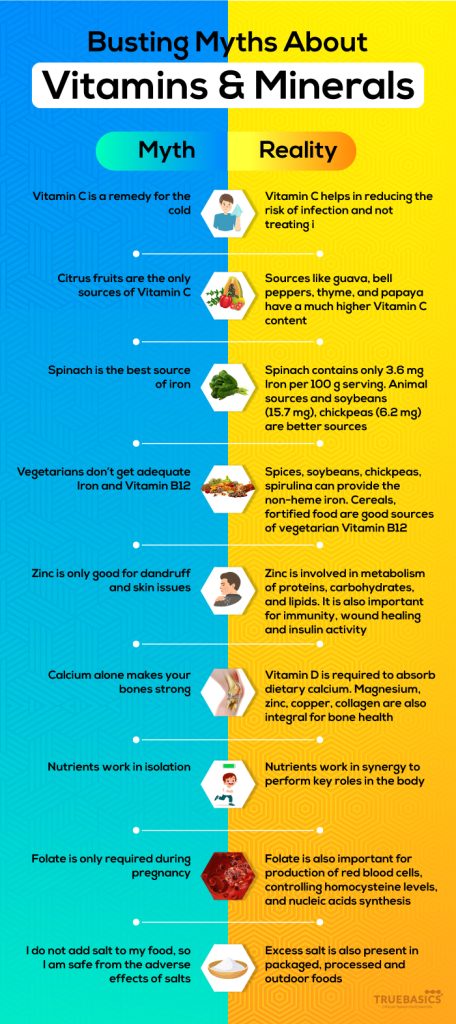
In Conclusion…
Nutrition is a complex science and any attempts to oversimplify it or make it linear result in the formation and propagation of myths. In the endeavour to live fully and sustain vitality in our bodies, it is important to be aware of the role of nutrients, dietary limits, right sources and eating an overall balanced diet.
#ShareIfYouCare #RepublicofDeficiency
Sources:
[1] https://www.ncbi.nlm.nih.gov/pmc/articles/PMC6367879/
[2] https://www.ncbi.nlm.nih.gov/pmc/articles/PMC6611390/
[3] https://www.ncbi.nlm.nih.gov/pmc/articles/PMC2790195/
[4] https://www.ncbi.nlm.nih.gov/pmc/articles/PMC4469220/

